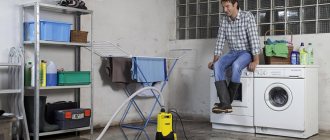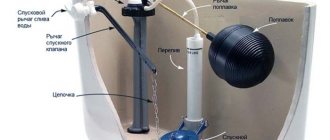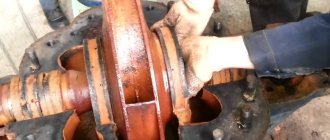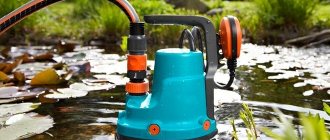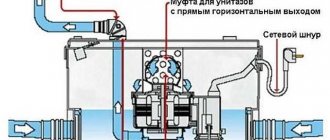Home / Eco life / Engineering systems / Water supply / Pumping equipment
Back
Published: 10/25/2015
Reading time: 6 min
0
14866
The issue of water supply becomes especially acute after acquiring ownership of a dacha that does not yet have an autonomous water supply . And if it is quite possible to bring water for cooking from a neighbor’s well, then solving the problem of other household needs and especially watering the beds is much more difficult - carrying water in buckets takes a long time and is physically difficult.
The most unpleasant situation arises when the owners do not have enough funds to drill a well, at least for technical water. Or, due to some circumstances, for example, in the absence of an electrical network, they cannot afford to purchase a pump in a store to connect it to an existing well. However, it is better not to supply water to a private home using homemade devices. For this purpose, it is necessary to use high-quality industrial designs.
- What can a homemade pump do?
- What is it made of and how is it made? Wave pump
- "Bake"
- Hand pump
- Plastic bottle pump
Methods for lifting water without an electric pump
If you are deciding how to raise water to a height, you cannot do without a pump. Only for lifting you will have to use not electric, but hand-made home-made devices, the operation of which will require the application of muscular force or the energy of the current water flow.
Archimedes screw
The invention of a screw device for supplying water to heights to fill irrigation canals was made by Archimedes around 250 BC.
Fig.1 Operating principle of the Archimedes screw pump
The device consists of a hollow cylinder, inside of which a screw rotates; during operation, it is lowered into the water intake source at an angle. As the propeller blades rotate, they capture water and the propeller lifts it up the pipe; at the top point, the pipe ends and the water is poured into a container or irrigation channel.
In ancient times, the impeller was rotated by slaves or animals, in our time there may be problems with this and you will have to additionally build a wind wheel to drive the propeller into rotation or strengthen the muscles yourself.
Fig. 2 A variation of the Archimedes wheel - a tube pump
The device is an analogue of modern screw pumps and can have various modifications: the screw rotates with the cylinder or has the shape of a hollow tube wound around a rod.
Montgolfier hydroram method
Mechanic Montgolfier in 1797 invented a device called a hydraulic ram. It uses the kinetic energy of water flowing from top to bottom.
Rice. 3 Operating principle of a hydraulic impact water pump
The principle of operation of the device is based on the fact that when the water flow in a rigid pipe is suddenly blocked, water is forced through a check valve under pressure into the hydraulic tank located at the top. In its lower part there is a fitting on which the outlet water hose is attached, going to the consumer. The non-return valve prevents water from flowing back out - thus, there is a constant cyclic filling of the tank and a continuous rise and supply of water.
The shut-off valve of the device operates automatically, so the presence of a person and the organization of his work other than installing the equipment is not required.
Rice. 4 Appearance of an industrial hydraulic impact pump
It should be noted that there is no need to make such devices yourself; they are produced industrially in small volumes.
Airlift
The founder of the method is the German mining engineer Karl Loscher, who invented the method in 1797.
Aerolift (airlift) is a type of jet pump that uses air to lift water. The device is a hollow vertical pipe lowered into water, to the bottom of which a hose is connected. When air under pressure is supplied through a hose into the pipe, its bubbles mix with water, and the resulting foam rises upward due to its light specific gravity.
Air can be supplied using a conventional hand pump through a nipple that prevents it from escaping back.
Rice. 6 Automatic water supply by airlift using a compressor
It is quite easy to make such a device for supplying water in the absence of a pump with your own hands and automate the process if there is a compressor supplying air.
Lifting water with a piston pump
You can make a device for supplying water to a height using the suction method using a piston. The device is a pipe with a system of check valves, inside the cylindrical surface of which a piston moves. During the return movement, water is sucked into the cylinder body; when the piston moves forward, the check valves close and the water is pushed out.
Rice. 8 Piston pump in the organization of manual water supply.
Holding a piston pump with a long pipe for lifting water from great depths in your hands and pumping water is an activity for trained bodybuilders; it is more convenient to adapt it to lifting water from a narrow well, attaching it to an external column with a handle.
To quickly lift water from shallow depths from narrow crevices, you can use a simple industrial device. To do this, take a manual water pump and put a long plastic tube on its inlet valve. A homemade pump is lowered into the water with the long end of the tube and it pumps by repeatedly pressing the pump button.
Pumping water without using a drainage system
So, pumping water out of the basement with a pump is not too difficult a job. However, it is worth preparing for it.
The following equipment will be required:
- Directly the pump, which in terms of parameters will be suitable for each specific case;
- Special hoses through which water will be pumped out of the basement. It must be said that their length in each individual case will be different, which depends on the location of the drain;
- Electrical socket for pump operation or extension cord;
- Special clothing, such as rubber boots or waterproof overalls.
It was said above that the pump must be suitable according to its parameters. Indeed it is. Let's consider different types of pumps and cases of their application.
Types of pumps and their parameters
All pumps can be divided into three large groups:
- Surface aggregates;
Outdoor unit representative
- Submersible;
One of the types of submersible pumps
- And drainage.
Drain pump with float
The first type has a relatively low power, so it is often used only seasonally, and only with sufficiently clean water. It is allowed to contain dirt particles, the size of which will not exceed 1 cm.
The principle of its operation is very simple:
- A level area is located or being prepared;
- The entrance hose is lowered to the bottom of the flooded room;
- The outlet sleeve is pulled back to the place where the water drains.
The advantage of such a system is that it is easy to install with your own hands. The disadvantage is the fact that this machine for pumping water from the basement is constantly located outside, so even in mild frosts there is a chance of water freezing in the hoses.
Immersion of the inlet hose into the well
The second type of units has slightly greater power and greater productivity. For this reason, such pumps are capable of pumping out fairly dirty water (containing dirt particles exceeding 5 cm).
This type of equipment must be partially or completely submerged under water
It is worth noting that this type has two types:
- Household units;
- And industrial devices.
It is clear that the second type has a higher price and is capable of working with very large volumes. For this reason, domestic submersible pumps should be chosen for private use.
The principle of their operation is as follows:
- The pump is completely immersed in water;
- The outlet hose (usually there is only one) is led to the place where the water is drained;
- The unit is connected to the power supply (the outlet, of course, should be located away from moisture).
The drainage unit is capable of pumping water even from an open reservoir
Advice! When choosing such a unit, special attention should be paid to such parameters as:
- Location of the suction element;
- The presence of a float that automatically turns off the pump;
- Power.
To completely pump out water from the basement, the suction element must be located at the very bottom of the unit. As for the float, this is a necessary device that will automatically turn off the pump when work is completed.
The fact is that such pumps are cooled by the water around them. When it runs out, the unit begins to get very hot, and the float prevents this, as it automatically stops the pump.
As for power, it is measured in the volume of water pumped per unit of time. If you plan to pump water from simple, not very large rooms, then a capacity of 120 l/min will be sufficient. It must be said that the price of such units is lower.
As for the third group, the pumps that belong to it are the most powerful. In fact, they can be called universal. Such pumps are capable of handling waste of various sizes.
Advice! In the case when a pump is purchased for the purpose of pumping out water due to floods or serious flooding during the rainy season, it is better to choose this category.
We pump out water from the basement.
Indeed, floods bring with them not only water, but also various debris, which only a drainage pump can handle. For this reason, before pumping water out of the basement, you should carefully consider the choice of tool for this.
This unit works according to the following principle:
- Draws in water and debris;
- The mixture enters a special chamber - a grinder;
- After this, small particles of debris are removed outside.
A few words should be said about individual units that are manual. A pump for pumping water out of the basement can be used when there is simply no electricity nearby.
Cleaning the cesspool
Fecal pump
It is better to use a surface pump. Only the hose is immersed in the pit; the installation itself is located on the ground or in a separate room.
Submersible fecal pumps with grinders are available on the market.
The submersible pump is lowered into the septic tank. This unit is impractical to use for periodic pumping. Since for the most part it is constantly in a septic tank. It is simply inconvenient to take it out and clean it every time.
Attention! It is recommended to use a submersible pump for small septic tanks that are subject to frequent pumping. The equipment remains in the storage tank; lifting it to the surface is not necessary.
Submersible pumps with a grinder operate autonomously, which is very practical when the septic tank frequently overflows. As soon as the wastewater level rises to a certain level, the unit turns on automatically.
Container for waste that will later need to be removed
The tank for storing and transporting wastewater must be airtight with a tight-fitting lid. It’s great if it is of large volume, in which case several pumpings can be made into it. Removal and disposal will need to be done less frequently.
In most cases, black plastic tanks are purchased to store wastewater.
Black barrels are intended for storing liquids outdoors. They are highly durable. Withstands temperatures from -40 0 to +50 0. Resistant to aggressive environments and have high tightness.
How to pump out sludge from a drain pit
Before you start cleaning the septic tank, it would be a good idea to add a special bioactivator to the pit 2-3 days before pumping. The product is not expensive, but the benefits from it are enormous.
Bioactivators for cleaning a septic tank dilute the sediment. They literally make it liquid. This speeds up the pumping process, saves energy resources and protects the pump from overloads.
Leading drugs: Doctor Robik 109, Doctor Robik 409 (even dissolves fossilized sediment), BIOSEPT, DEO TURAL (can be used at any temperature and for any septic tank).
After all the preparations, you can start pumping.
If a submersible pump is used, the outlet hose is inserted into the container and pumping is performed.
If the pump is a surface pump, then the suction hose is lowered into the pit to the bottom, and the outlet pipe is lowered into the prepared container.
During the pumping process, do not leave the equipment unattended; vibration may cause the hose to jump out of the tank.
The amount of contents in the septic tank should be checked periodically.
Pump out a cesspool without a pump
The process is labor-intensive and unpleasant. You can't do the cleaning alone.
Will be needed
- Sealed suit
- Respirator
- Gloves
- Bucket
- Staircase if the septic tank is large.
- Rope
- Shovel
The stairs lead down into the pit. The sludge is collected into a bucket with a shovel. Using a rope, the contents are lifted to the surface and poured into a compost pit or container.
And so on until the septic tank is completely empty.
The procedure is not only unpleasant, but also dangerous.
Toxic fumes from the sediment can cause loss of consciousness.
If you fall into the mud, you may drown.
Important! It is recommended that at least two people work together to pump out the pit manually, for safety reasons.
You can pump out not only a single-chamber septic tank yourself, but also one consisting of two or three tanks.
It is better to do this with a pump
- The first tank is pumped out, in which the wastewater settles and the primary sediment settles.
- Second camera. If there is a biofilter, it must also be cleaned. It is not necessary to empty the second tank completely; it is enough to remove the sediment.
- Next, the third chamber is freed from sludge.
It is worth noting that thanks to the use of bacteria, the amount of sludge in septic tanks is significantly reduced. The sediment becomes liquid, without large particles.
Do-it-yourself pumping of a cesspool
If the cesspool is small and its waste mainly consists of water, then you can clean it yourself.
In order to pump out a drain hole with your own hands, you need the following:
- water or fecal special pump;
- a container where waste should be collected in order to be removed later.
As for the container for collecting and transporting sewage, it should be large and covered with a lid. If you use such a container, you can handle it in one go and remove everything at once, which will significantly save time.
Now you should proceed directly to pumping the cesspool. If you plan to use a water pump for this purpose, then you must first equip it with additional filters, which is done to ensure that the pump does not become clogged during operation, otherwise repairs will be required, which can be expensive. However, it is still preferable to use a special pump for feces. In order for such equipment to function normally, it is recommended that all liquids in the cesspool be pre-homogenized. You can use modern fecal pumps with a special cutting mechanism for grinding. Such equipment is reliable and convenient, and if you use it skillfully, repairs will not be needed for long.
If the drainage pit has small volumes and dimensions and fills in a short time, then it is preferable not to remove the pump from the pit, but to keep it there permanently. It should be borne in mind that modern fecal pumps can operate automatically. This is very convenient, since when the pit is filled to a certain level, such equipment automatically filters and pumps out all impurities.
How to avoid pumping out a cesspool for 10 years
- 1. What causes siltation in a cesspool?
- 2. How long to avoid pumping out a cesspool - simple tips
If you pump out your cesspool every year or more often, then this is a problem that definitely needs to be addressed. Perhaps the cesspool simply silted up over time, after 5-7 years of use, or perhaps its volume is small, and the wastewater simply has nowhere to go.
Be that as it may, you can solve the problem with frequent pumping of the cesspool in various ways. This article from the construction magazine samastroyka.ru will provide effective advice on how you can avoid pumping out a cesspool for decades.
Biological products for cesspools and sewers
The Waste Treat biological product is a chemically non-aggressive liquid containing six anaerobic microbial cultures. This is a safe complex of microorganisms designed for accelerated processing of feces and household waste in septic tanks and cesspools.
It can handle phosphates and nitrates in wastewater. Eliminates all unpleasant odors in septic tanks, cesspools and toilets, processes organic waste, turning it into liquid.
The biological product "Wast Treat" is intended for cleansing:
- Drainage systems.
- Reducing the volume of waste in a cesspool or septic tank.
- Outdoor toilets and septic tanks.
- Eliminates unpleasant odors.
How long not to pump out a cesspool - simple tips
If the siltation of the cesspool is associated with lathering, then, in this case, you can use special preparations. Such preparations contain special bacteria that will help effectively process soap deposits, as a result of which water will begin to drain from the cesspool into the ground.
By the way, regarding bacteria for septic tanks and pits, they show quite good results. If you regularly use them in your cesspool, then you can forget about its siltation, once and for all.
Bacteria not only break down organic waste in the cesspool, but also help get rid of the unpleasant odor. As a result of their use, the amount of waste will significantly decrease.
Below are tips on how long to avoid pumping out a cesspool:
Pit dimensions
. If you have to pump out the cesspool every year, then perhaps its volume is not enough for the entire house. There is only one way to solve the problem once and for all - by increasing the volume of the cesspool. If the drainage pit is made of concrete rings, then you need to add several new ones.
It will also help to solve the problem by installing drainage wells around the pit so that water flows well into the ground. Well, as a last resort, when there is no way to modernize the old cesspool, you can make another one nearby by connecting the old and new pits with an overflow (based on the design principle of septic tanks).
Cleaning the cesspool
. Yes, this work is not a pleasant one, but sometimes the deposits on the walls of the pit are so large that it simply cannot be done without mechanical cleaning.
Planting vegetation
. I don’t pump out the cesspool for a long time and my secret is simple. Near the pit there are several large trees that suck out water well. Most plants are known to love water very much. For example, the same Bird Cherry, it is capable of consuming more than 100 liters of water in just one day.
When planning the construction of a cesspool, you can take this fact into account. And if there is a large plantation of trees nearby, then the pit may not be pumped out for ten or more years.
Modern methods of pumping cesspools
Installation diagram of a septic tank and filtration field.
If we are talking about plastic cesspools, then they should be cleaned by specialists. Pumping out of a plastic drainage pit can only be carried out if a sewage truck arrives at a certain place, and there must also be a supply of electricity and water. In order to clean a sealed septic tank, including a plastic one, biological products are increasingly being used. The basis of such biological products is microorganisms, which must utilize sewage waste as much as possible. Bacteria for drainage pits break down and process wastewater. Filling a hole with such biological preparations is very effective, but before filling the hole, you should know that such bacteria for a septic tank are microgranules made of natural polysaccharide, and microorganisms live in such microgranules.
If you fill a cesspool with biological products, their efficiency will increase, since solid fractions are processed into a liquid state in a fairly short time.
Industrial water treatment
Water purification using a septic tank.
It happens that during pumping, some defects form in cesspools, and then repair of such pits is required. If the cesspool is made of brick, then you should first dig out the outside wall of the cesspool in the right place and install concrete foundation blocks in the problem area. If the cesspool is made from a polyethylene container, car tires or a barrel, then in this case the services of a manipulator will be needed. Old storage accessories are installed, installed and repaired, then the pit is leveled, then concrete rings should be installed. That is, at the exit there is a cesspool made of rings.
However, it should be borne in mind that repairing a cesspool made of concrete rings by pouring concrete is unlikely to be possible. The fact is that concrete cannot be attached to the walls of a reinforced concrete structure that are saturated with fatty waste. If a drain hole without a bottom cannot cope with the wastewater and the water stops draining, then another hole should be made, which is connected to the first hole by an overflow. That is, an overflow septic tank is built from two wells, which will provide reliable sewerage for a long time.
Read also: How to tie up currant bushes with your own hands
Useful tips
In order for a sewer truck to be able to pump out your drainage pit without any problems, when organizing the drainage pit, it is necessary to take into account that the hose of the machine must freely reach the bottom of the pit.
Pumping out cesspools should begin directly from the site where they are installed. In order for pumping to be conveniently accessible, it should be located no closer than 30 m from the well, 12 m from the house, 1.5 m from the land. Drain pits should be pumped out at least once a month, but much depends on the degree of load on the pit and its volume and type are taken into account. If the cesspool is located on a summer cottage where people rarely come, then it is quite possible to clean the pit once every six months. Nevertheless, such a procedure should be carried out for preventive purposes; there is no need to wait until the pit overflows. If the tank overfills, it becomes an excellent habitat for bacteria, and the concentration of toxic substances increases. In addition, everything that is in the drainage pit penetrates into the soil, and this causes a significant deterioration in the environmental situation on the land plot.
In private houses, wastewater collection is carried out by local sewerage. Trouble-free operation of the structure is guaranteed by periodic pumping of cesspools.
Two disposal options are used: collection of sewage in settling tanks or containers and septic tanks - devices for bacterial treatment of household wastewater, including the use of automation.
Purpose
When studying the operating principle of a small treatment plant, one pattern can be noticed. After pumping out wastewater, deposits of silt and other contaminants regularly accumulate on the walls of a cesspool or well. Such an environment promotes the proliferation of harmful and pathogenic microorganisms. Regular removal of sewage from the septic tank makes the sewage system more efficient and creates a favorable sanitary environment.
The use of factory-made equipment will allow you to more effectively cope with the task, but it has a rather high price. In this case, at your summer cottage or in a country house, you can use a homemade pump to pump out the sewage system. Proper assembly of the device will ensure effective removal of wastewater.
Operation, care, tips, recommendations
It is important to periodically carry out preventive maintenance:
- Monitor the water level in the mine and pump out the liquid fraction in a timely manner.
- If the well has no bottom and quickly fills with waste, it is necessary to clear the bottom of the hole from silt.
- The sealed chamber does not drain moisture, and the accumulation of liquid is systematic, as well as its removal. When the need to remove liquid waste becomes more frequent (a sign of accumulated sludge), the well requires cleaning.
- Depending on the volume of the well, the drainage liquid can be removed using a pump or a sewer truck, and for thorough cleaning of the chamber from sludge and fatty deposits, it is better to invite specialists with a suction pump.
- A completely filled well should not be allowed to be used in winter. Before frost arrives, the liquid must be pumped out.
Proper operation of sewerage in a private home
In order for the cesspool to not silt up and the sewage system to work reliably in the house, it is necessary to operate the system correctly and carry out timely preventive maintenance, starting from the drainage areas in the room and ending with the chamber:
- Do not throw garbage into the sewer system, which can get stuck in the pipes and contribute to the rapid accumulation of silt deposits at the bottom of the chamber;
- periodic cleaning of drain pipes with caustic soda allows you to dissolve fatty deposits accumulated on the walls and allows free movement of moisture;
- It is important to promptly detect and repair a leak in the system, which can lead to a lack of water to move waste through the pipes and lead to a blockage.
Information from the video about maintaining the waste chamber and sewer system in a private house will allow you to avoid mistakes when operating the sewer system and ensure trouble-free operation.
Material
You can make vacuum pumps for pumping out sewerage with your own hands, since they do not have complex components. First of all, you need to prepare the materials and devices that will be needed for the work. They can be bought in stores or supermarkets. To work you will need the following:
- Submersible pump, model “Baby”.
- Several metal strips or rods.
- Mesh with small cells.
- Steel cable, strong cord or rope.
- Welding equipment.
Installation
To make a vacuum pump for pumping out sewerage with your own hands, you do not need to disassemble factory equipment. Its technical capabilities are suitable for use for such purposes. The installation of a mesh with small cells will make the operation of the device more efficient. This design will allow only fractions of the required size to pass through.
Assembly and installation are performed according to the following scheme:
- A frame is assembled from steel slats, connecting individual elements by welding.
- The frame is covered with a mesh with cells no larger than 10*10 mm. This size can prevent large debris from entering the work area. The baby sewer pump copes well with smaller fractions.
- A cable, rope or cord is secured to the top of the frame.
- Pumping equipment is installed inside the structure and firmly fixed.
- The cage is immersed in a cesspool or well, trying to place the equipment in the central part. With greater immersion, silty deposits will be drawn in from the bottom; location on the surface leads to clogging with fatty deposits. In both cases, the result will be a temporary stop of the device.
Possible installation errors
Do-it-yourself installation of the device must follow all the rules in order to avoid unforeseen situations. When installing, pay attention to the following points:
- The cable used must be suitable for the motor power. Very often, a wire of insufficient cross-section or with fewer cores is used for connection.
- The unit must be firmly fixed. Otherwise, diving is strictly prohibited.
- The work must be controlled by automatic devices. Otherwise, dry running can cause serious damage to the pumping equipment, including complete stoppage.
- Before diving, you need to check that the pipes at the inlet and outlet of the device are connected correctly.
- It is very important to purchase only high-quality materials for making a homemade device that removes wastewater from a cesspool or well.
Operating rules
A home-made pump for pumping out sewage with your own hands will serve for a long time, provided that the operating rules are followed:
- Regularly remove the mechanism, inspect it, identify malfunctions in the operation of components and connections. It is not recommended to lift the pump to the surface without first disconnecting it from the power supply.
- If there is a cutting mechanism, check its performance.
- To avoid the formation of grease deposits, regular washing of the internal parts is required. To do this, just hold it in a container with very hot water for a few minutes. For uninterrupted operation of the pump, it is advisable to consider the possibility of an additional power source, for example, a generator.
- After completing maintenance, be sure to check the operation of automatic devices and mechanisms.
- Before the next dive, you need to check the serviceability and correct operation of the mechanisms. The equipment is connected to the water supply network and pumps clean water.
Methods for pumping out cesspools
There are two main methods that allow you to pump out a cesspool:
- On one's own.
- Using a sewer truck.
The second option at first glance looks much simpler: just contact a specialized company, and the problem will be solved. There are a number of nuances here that must be taken into account - otherwise the risk of trouble is quite high.
- the cost of services for pumping out cesspools is quite high: calling a specialized vehicle will cost a large amount;
- any machine for pumping out cesspools has rather large dimensions, and they do not always allow one to approach the pit at a distance sufficient for pumping;
- some companies provide services for pumping out cesspools without having special permits for this: in this case, all pumped out waste can be taken to an illegal place, and all responsibility for this will fall on the owner of the pit;
- ordering a sewer truck does not always guarantee high-quality pumping, and a poorly cleaned pit will not perform its duties efficiently, so calls for sewer trucks will become more frequent.
All these shortcomings allow us to come to the conclusion that pumping out cesspools can be done with your own hands, because a good owner will definitely take care of the high-quality and competent operation of this system.
How to clean, methods
Each method of keeping wastewater treatment plants clean and operational has its pros and cons. Effective cleaning depends on the design of the specific cleaning facility and the financial capabilities of the owners of country houses or private houses. The main ways to get rid of impurities include:
- using sewage pumps to pump waste fluid out of the structure;
- manual cleaning of the mine with a bucket is used after removing the liquid fraction from the pit;
- a sewer truck pumps the mass into a tank using a vacuum pump;
- the use of biological products in a septic tank with a sealed bottom for the decomposition of solid waste and recycling into water;
- chemicals are used in sealed septic tanks to process waste into water with subsequent pumping into a sewer machine:
- the use of a sludge sucker for the solid layer of sludge and waste at the bottom of the mine.
When deciding what to do with silted drainage, you need to familiarize yourself with all the options for removing sewage and use the one that is more effective in a particular cesspool.
1) To pump out the sump, fecal, deep-well pumps . When choosing a pump, we focus on the following parameters:
— depth of the shaft and distance to the container from which the pumped liquid is removed;
— pump performance and power depending on the chamber volume;
— density of the pumped waste mass.
The most reliable and productive model for this work is a fecal pump with a grinder, which allows you to crush and pump household waste.
2) Manual cleaning of the cesspool is a forced procedure when there is no access to the drain. A popular method of cleaning, the work is unpleasant, but less expensive if you do it yourself.
For this operation you need inventory and the correct sequence of actions:
- used for work: shovel, bucket, rope; scraper, metal brush, gas mask;
— to remove sediment and dense deposits, the liquid mass is first pumped from the bottom of the well into the storage tank;
- using a gas mask, remove grease deposits from the walls of the shaft with a scraper and brush;
- silt deposits are removed from the bottom of the well, using a shovel and a bucket with a tied rope; it is necessary to attract an assistant who will pull out a bucket of waste and take it to a storage container;
— after cleaning is completed, a layer of gravel is poured onto the bottom of the pit for better drainage, and the walls of the shaft are disinfected with a special antiseptic or chlorine.
The same procedure can be applied to a silted outdoor toilet. Preliminary pumping of moisture is not required due to the lack of drains from the room.
Manual waste removal is possible with small dimensions of the drainage area. The construction of volumetric chambers must be planned near the road, for the access of specialized equipment.
Read also: Which roses bloom all summer until autumn
3) It is convenient to pump waste liquid out of the mine using a sewer truck . For the equipment to operate, it is necessary to have access to the chamber so that it is possible to lower the suction hose to the bottom.
A vacuum pump uses a hose to pump liquid waste into a container on a vehicle for further disposal at a designated area.
The cost of the service of sewage disposal equipment is determined by departure, so a chamber with a small filling volume (less than the capacity of a car) will require frequent visits, which is disadvantageous for the home owner. In this case, it is more economical to have a storage tank with a volume no less than that of a sewage disposal unit and to invite equipment to pump out waste after it is filled.
4) The use of aggressive chemicals is effective, but environmentally unsafe. Nitrate oxidizers dilute sludge and solid waste and help eliminate odors.
But in order for the liquid after treatment with the drug to be safe, like nitrate fertilizers, it is necessary to monitor its concentration in the waste chamber.
Pumping out a hole using a pump
To implement such cleaning, you will need a container that allows you to drain the liquid. The container must be securely closed and have a large volume so that the work does not have to be done repeatedly (read also: “Container for a cesspool - types and their advantages”). In addition, you will need a sewage pump. Which pump should I use to pump out a cesspool? If necessary, you can use a simple pump, but it will have to be equipped with a filter, otherwise sewage will simply clog the structure.
In any case, it is necessary to pump out pits in private houses regularly, and it will be much more profitable for the owners of such houses to purchase a specialized pump for a cesspool, which will serve its owners for many years.
A good option is to install an automatic pump, which results in a cesspool without pumping. In those areas where people permanently live, a do-it-yourself cesspool without pumping is the most suitable design.
Pumping water: making a pump yourself
The issue of water supply becomes especially acute after acquiring ownership of a dacha that does not yet have an autonomous water supply . And if it is quite possible to bring water for cooking from a neighbor’s well, then solving the problem of other household needs and especially watering the beds is much more difficult - carrying water in buckets takes a long time and is physically difficult.
The most unpleasant situation arises when the owners do not have enough funds to drill a well, at least for technical water. Or, due to some circumstances, for example, in the absence of an electrical network, they cannot afford to purchase a pump in a store to connect it to an existing well. However, it is better not to supply water to a private home using homemade devices. For this purpose, it is necessary to use high-quality industrial designs.
Cleaning a pit without a pump
The algorithm for performing actions will be as follows:
- A few days before cleaning, it is necessary to homogenize the liquid using special substances.
- To carry out cleaning work, you need to wear suitable clothing, and you need to choose from those things that you don’t mind. All things must cover the body from accidental ingress of waste.
- Now you can take an ordinary bucket and rope, with the help of which you scoop out the waste. When the next portion of sewage is raised, it must be poured into a specially prepared container for further waste disposal.
- The pumped out sewage is disposed of. The water raised from the pit can be poured out, but sewage waste must be taken to specially designated places.
- After cleaning, the pit must be rinsed with water, preferably using pressure, so that deposits do not appear on the walls of the tank, interfering with normal functioning.
- The last stage is cleaning the sewer pipes, which must be done as thoroughly as possible.
This process is very unpleasant and quite complicated, so many homeowners still prefer to use pumps (pro
How to pump out a drain pit without a pump?
Do-it-yourself septic tank without pumping (diagram).
In order to clean the drain pit, it is not necessary to have a pump; you can quite use the old “old-fashioned” method. This method involves attaching a bucket to a rope and carefully scooping up the sewage from the pit. Such work should be performed only in special clothing that hides all areas of the skin. This work involves little pleasure; many of those who have done it once prefer not to do it anymore and are looking for more acceptable options for cleaning the pit.
This cleaning method can be used in those pits that are very small in size and volume. This cleaning method does not use special equipment, so nothing can fail and no repairs will be needed.


